新实用汉语课本2第15课件
《新实用汉语》第二册15-16课
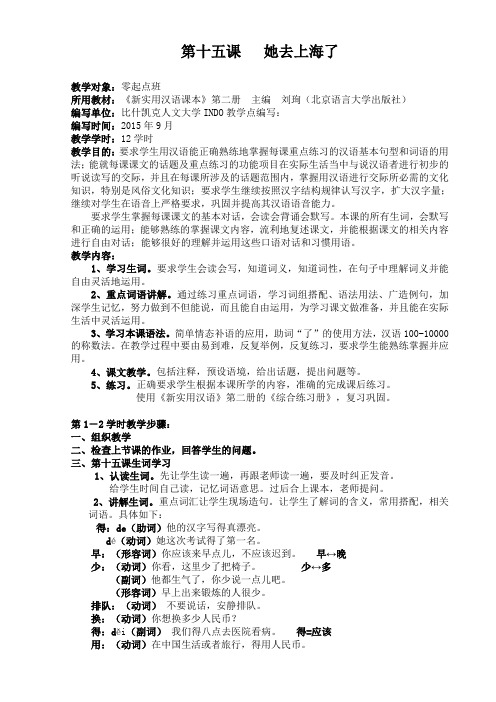
第十五课她去上海了教学对象:零起点班所用教材:《新实用汉语课本》第二册主编刘珣(北京语言大学出版社)编写单位:比什凯克人文大学INDO教学点编写:编写时间:2015年9月教学学时:12学时教学目的:要求学生用汉语能正确熟练地掌握每课重点练习的汉语基本句型和词语的用法;能就每课课文的话题及重点练习的功能项目在实际生活当中与说汉语者进行初步的听说读写的交际,并且在每课所涉及的话题范围内,掌握用汉语进行交际所必需的文化知识,特别是风俗文化知识;要求学生继续按照汉字结构规律认写汉字,扩大汉字量;继续对学生在语音上严格要求,巩固并提高其汉语语音能力。
要求学生掌握每课课文的基本对话,会读会背诵会默写。
本课的所有生词,会默写和正确的运用;能够熟练的掌握课文内容,流利地复述课文,并能根据课文的相关内容进行自由对话;能够很好的理解并运用这些口语对话和习惯用语。
教学内容:1、学习生词。
要求学生会读会写,知道词义,知道词性,在句子中理解词义并能自由灵活地运用。
2、重点词语讲解。
通过练习重点词语,学习词组搭配、语法用法、广造例句,加深学生记忆,努力做到不但能说,而且能自由运用,为学习课文做准备,并且能在实际生活中灵活运用。
3、学习本课语法。
简单情态补语的应用,助词“了”的使用方法,汉语100-10000的称数法。
在教学过程中要由易到难,反复举例,反复练习,要求学生能熟练掌握并应用。
4、课文教学。
包括注释,预设语境,给出话题,提出问题等。
5、练习。
正确要求学生根据本课所学的内容,准确的完成课后练习。
使用《新实用汉语》第二册的《综合练习册》,复习巩固。
第1-2学时教学步骤:一、组织教学二、检查上节课的作业,回答学生的问题。
三、第十五课生词学习1、认读生词。
先让学生读一遍,再跟老师读一遍,要及时纠正发音。
给学生时间自己读,记忆词语意思。
过后合上课本,老师提问。
2、讲解生词。
重点词汇让学生现场造句。
让学生了解词的含义,常用搭配,相关词语。
她去上海了新实用汉语课本二册第15课

Jenny
得
A word or phrase which follows the predicate to illustrate the degree ,manner or nature of an action is called the complement of degree. 你每天几点睡觉? 你每天睡得很晚/很早。
非常好 刚从
西安回北京。你真喜欢旅行!在西
。
好不好 ? 还可以。这次住得 不太好 。
林娜:吃得
明信片 旅行 该 介绍介绍 看看 数一数 参观
丁立波:你 参观 兵马俑了没有?
明信
林娜:我参观兵马俑了。我还买了很多 片
丁立波:好啊!我也很想去西安
旅行
。你到我那儿去看看 吧。
介绍介绍
。你给我
睡觉
帮忙 结婚 订婚be engaged to 离婚 devorce
Reduplication of the verb
some verb can be reduplicated to make a sentence sound casual or informal .
It also expresses meaning in a circumlocutory tone.
sometimes a verb is reduplicated to indicated that the action is of very short duration ,or to imply that what is done is just for the purpose of trying something out . The reduplication follows the pattern "AA" or "A一A"
新实用汉语课本第二册 第十五课 她去上海了

教学目的3
掌握汉字 (1)会认、会写基本汉字:民、千、币、换、 丘、甬、亚、车、重、尤 (2)会认、会写课文中的词汇:早、银行、 排队、换、英镑、 从、次、参观、兵马俑、 明信片、工作人员、王府井、西安、发展、普 通话、年轻、流利、懂、就
教学步骤
1、复习旧知识 2、生词学习 3、学习重点句型和重点词汇 4、讲练课文 5、练习以及相关文化知识的学习
1001,2002,5005
1030,5080,9060Βιβλιοθήκη 1200,2400,3600
万
10000,20000,30000,40000 50000,60000,70000
10002,30004,50006
10010,20030,40060,90080
30400,50800,60700
一、复习就知识
1、教具准备:生词卡片 帮助学生回忆一些生词,以便能够更好地进入 新知识的学习 2、就以前学过的句型和语法以及功能会话与 学生交流
二、生词
得
早 银行 少 排队 换 英镑 人民币 得 用 刚 从 非常 次 参观 兵马俑 明信片 该 工作人员 千 数 王府井 西安
数
数一数 数数
数钱
数人民币
王府井
西安
课文
林娜:力波,你来得真早
。
丁力波:刚才银行人少,不用排队。林娜,
你今天穿得很漂亮啊。 林娜:是吗?我来银行换钱,下午我还要 去王府井买东西。 丁力波:今天一英镑换多少人民币? 林娜:一英镑换十一块五毛七分人民币。 明天我要去上海旅行,得用人民币。 丁力波:什么?明天你要去上海吗?你刚从 西安回北京,你真喜欢旅行!在西安玩儿 得好不好?
新实用汉语课本

71 /35
Hàn zì bǐ shùn 汉字笔顺
mǎ 马
SCU CS
本科毕业论文答辩PPT示范
72 /35
Hàn zì bǐ shùn 汉字笔顺
nǚ 女
SCU CS
本科毕业论文答辩PPT示范
73 /35
Hàn zì bǐ shùn 汉字笔顺
wǔ 五
SCU CS
本科毕业论文答辩PPT示范
74 /35
héng 一
SCU CS
本科毕业论文答辩PPT示范
62 /35
竖
丨
bǐ huà 笔画 trazos
shù 木
SCU CS
本科毕业论文答辩PPT示范
63 /35
bǐ huà 笔画 trazos
撇
丿
piě 力
SCU CS
本科毕业论文答辩PPT示范
64 /35
bǐ huà 笔画 trazos
捺
nà 八
Hàn zì bǐ shùn 汉字笔顺
mù 木
SCU CS
本科毕业论文答辩PPT示范
75 /35
Hàn zì bǐ shùn 汉字笔顺
huǒ 火
SCU CS
本科毕业论文答辩PPT示范
76 /35
Wǒmen xuéxí hànyǔ .
Dì yī kè pīnyīn 第一课 hànzì
shēngdiào
Dì yī kè
shēngmǔ
yùnmǔ
Wǒmen xuéxí yùnmFǔinals.
aoeiuü
Initials
Wǒmen xuéxí shēngmǔ .
b(o) p(o) m(o) n(e) l(e) h(e)
为新世纪编写的《新实用汉语课本》
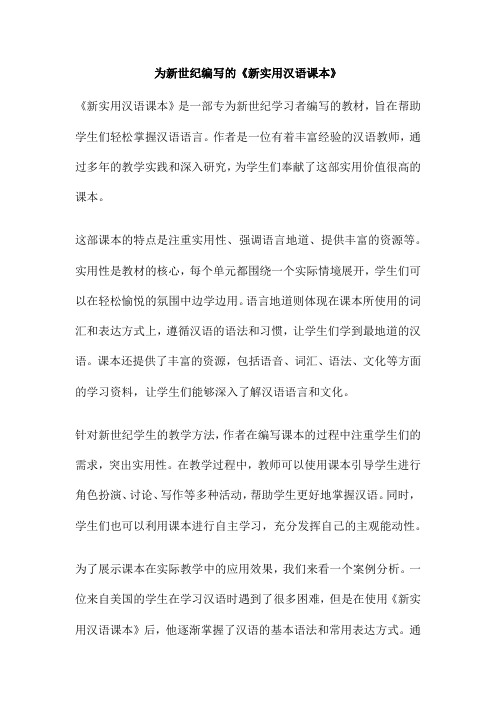
为新世纪编写的《新实用汉语课本》《新实用汉语课本》是一部专为新世纪学习者编写的教材,旨在帮助学生们轻松掌握汉语语言。
作者是一位有着丰富经验的汉语教师,通过多年的教学实践和深入研究,为学生们奉献了这部实用价值很高的课本。
这部课本的特点是注重实用性、强调语言地道、提供丰富的资源等。
实用性是教材的核心,每个单元都围绕一个实际情境展开,学生们可以在轻松愉悦的氛围中边学边用。
语言地道则体现在课本所使用的词汇和表达方式上,遵循汉语的语法和习惯,让学生们学到最地道的汉语。
课本还提供了丰富的资源,包括语音、词汇、语法、文化等方面的学习资料,让学生们能够深入了解汉语语言和文化。
针对新世纪学生的教学方法,作者在编写课本的过程中注重学生们的需求,突出实用性。
在教学过程中,教师可以使用课本引导学生进行角色扮演、讨论、写作等多种活动,帮助学生更好地掌握汉语。
同时,学生们也可以利用课本进行自主学习,充分发挥自己的主观能动性。
为了展示课本在实际教学中的应用效果,我们来看一个案例分析。
一位来自美国的学生在学习汉语时遇到了很多困难,但是在使用《新实用汉语课本》后,他逐渐掌握了汉语的基本语法和常用表达方式。
通过课本中的文化背景介绍,他还深入了解了中国的历史和文化,这让他更加热爱汉语学习。
《新实用汉语课本》是一部专为新世纪学习者编写的教材,具有很高的实用价值和使用价值。
它不仅能够帮助学生们轻松掌握汉语语言,还为他们了解中国的历史和文化提供了很好的途径。
我们相信,这部课本将会成为众多学习者的得力助手。
本文旨在对比分析《新实用汉语课本》与《博雅汉语》两本教材,以便学习者更好地了解两本教材的特点和优缺点,从而根据自身需求选择合适的教材。
《新实用汉语课本》和《博雅汉语》是两本广泛使用的汉语教材,它们在词汇、语法和难度等方面各有特点。
我们来比较一下两本教材的词汇。
《新实用汉语课本》的词汇更加常用和实用,注重口语和听力训练,而《博雅汉语》则更注重阅读和写作,词汇量相对较大,部分词汇较为生僻。
《新实用汉语课本》精读课示范课件
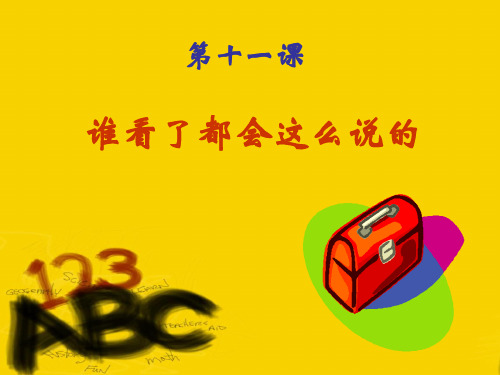
A:差不多每天都送。那家医院做的饭我爱人吃不下。 B:那你够辛苦的了。 A:可不是嘛!哎,小张,你能不能抽空给我孩子辅导辅导? B:我很愿意帮这个忙星期四个晚上都有课,下个月 要考试了。实在抱歉。 A:那你帮我想想办法吧! B:我看这件事情也不难办。你请个家教不就解决了吗? A:对,这是个好办法。你帮我找一个吧。 B:没问题。
例如: 谁都会这么说:这是个幸福的家庭。 他们什么也不让我干。 哪家父母不都希望孩子成为一条“龙”? 这件事我怎么也想不明白。(副词“也”一般用在否定句中)
(2)表示特指,疑问代词表示特指时, 同一疑问代词出现在前后两个分句 中,相互呼应,表示特指的人、事务、 性状等。前一分句表示条件时,后一 分句常用副词“就”。
你认为一个人几岁应该开始独立生活?
放(开)手:形容不过分干涉别人,
让别人按照自己的想法去做
父母不应该对孩子抓得过分紧,要放开手, 让孩子学会独立生活。
(一) 选字填空 Fill in the blanks with the right words
C 1. 欢迎各位光____ A邻 B领 C临 B 2.问题都___决了。 A减 B解 C简 C 3.作为一个___者,我觉得这本书写得不好。 A识 B语 C读
(六)对话(表示困难) Dialogue (showing difficulty) A:唉,当爸爸也不是那么好当的,你说是不是,小张? B:怎么啦?你儿子不是挺好的嘛! A:好什么呀!学校里考试常常不及格。我真伤脑筋。 B:我看你的孩子也不笨,可能是学习方法的问题。 A:你说得对极了。我看他学习也挺刻苦的,不知道为什 么考试常常考不好。 B:你为什么不辅导辅导他呢? A:唉,我哪儿有时间呀! B:噢,对了,你爱人生病住院了。 A:她住院快一个月了,下班以后我得做饭,还要给我爱 人送饭,回家已经十点钟了。 B:每天都要送饭吗?
新实用汉语课本第15课ppt
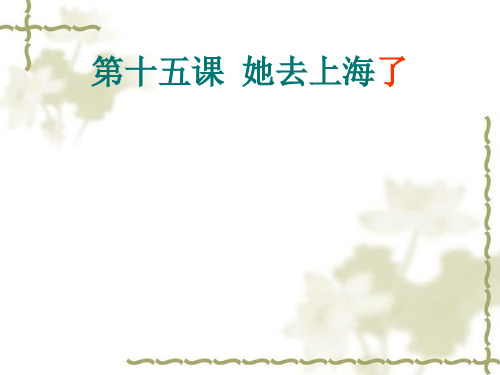
1、AB 复习复习 锻炼锻炼 打扫打扫 介绍介绍
reduplication of the verb
(action or idea of giving something a try) ( or a short time)
1、VV V一V 看看 听听 说说 等等 看一看 说一说 等一等
4.numbers
Xī’ān 西安
今天银行排队的人不多。
今天银行排队的人很多。
该
数(shu3)
参观
换
排队
1.我______了一下换的钱,没问题。 2.今天下午______我们班比赛了。 3.100JD能_____多少人民币? 4.今天我们去得很早,餐厅里不用______。 5.welcome来我们家______。
第十五课 她去上海了
yínhánɡ 银
xínɡ 行 行 不行?行
行
rén mí n bì 人 民 币
yīnɡbànɡ 英 镑
bīnɡmǎyǒnɡ 兵 马俑
兵马俑在哪儿? 去看兵马俑
mínɡxìnpiàn 明 信 片
很多明信片 一( )明信片 一张明信片 寄明信片 给朋友寄了一张明信 片
吃得还可以
The food (I had )was passable). Good ,not bad. 这个餐厅还可以。 汉语说得还可以。 住得还可以。
你到我那儿去看看吧。 你来得真早。 你刚从西安回北京。
请大家数数
多少个
得
in the text(1)?
课文的问题
城市
菜
地方
汇率
Exercises p.11
语法
新实用汉语课本

ÓraTankönyv oldalszám新实用汉语课本 1PinyinA négy hangsúlyA kínai szókezdők és szóvégzőkAlapvonásokVonás sorendA könyv szereplőinek bemutatása23/一4/二Az olvasmányban előforduló kifejezések magyarázata(你好、你好吗、你呢、也很好), továbbá a 吗 és 呢 közöttikülönbség ismertetése5/二5/三6/18/五(1,2), 9/56/29/3,4Feladat: Szókezdők felismerése (hehezetes-nem hehezetes stb.)6/3Feladat: Hangsúlyok felismerése6/4Feladat: A hármas hangsúly változása7/5Feladat: Tanteremben használatos kifejezések7/6Írásfejlődés, alapvonások, vonássorrend, gyökök10/七, 11/1,2, 12/3Új szavak4,5 Nyelvtan Mondatrészek sorrendje: Alany-Állítmány10/六2-12, 12 MunkafüzetMagnóhallgatás, írás (az írásjegyekből a tanár általmegadott formátumban sorminta írása, legalább 5 sornyi azA4 méretű füzetbe; a házi feladatot céljára ajánlatos 2 dbfüzetet használni, hogy a tanár be tudja szedni ellenőrzésreaz egyiket, majd cserélnek )1/1,2; 2/3,4,6; 3/7,9,1; 4/2,3,4;5/5(ezt a feladatot írásjegyekrevaló átírással is ajánlatosmegcsinálni),6A megadott számonkéréseken kívül minden hónapban egységes szintfelmérő dolgozatra kerül sor!OlvasmányAlapvető üdvözlési formák 1. - 你好!, 你好吗?FonetikaSzókezdők-szóvégzők: b,p,m,n,l,h,a,o,e,i,u,ü,ao,en,ie,in,ing,uoHangsúlyok, a hármas hangsúly változásaAz órai anyagként megadottak nem sorrendben szerepelnek, csupán az egyes órákon teljesítendő anyagot írják le!Órai anyag1.Bevezetés a kínainyelvbe (putonghua)A tanár saját maga által összeállított bevezető anyagsegítségével magyarázza el a kínai nyelv alapvető sajátosságait.ÍrásHázi feladatÓrai anyag megtanulása, új szavak megtanulása, Kulturismeret elolvasása (Hanyu -Putonghua)1. LeckeÓraTankönyv oldalszám新实用汉语课本 11. Lecke SzámonkérésHázi feladat beszedése, az esetleges problémák megbeszélése,szódolgozatOlvasmányAz olvasmányban előforduló kifejezések magyarázata(你爸爸妈妈好吗?、他们都很好、你要咖啡吗?、我要我要咖啡、我们都喝咖啡), valamint a 都 magyarázata16/二16/三16/120/五(2,3)17/220/五(1)Feladat: Szókezdők felismerése (hehezetes-nem hehezetes stb.)17/3Feladat: Hangsúlyok felismerése17/4Feladat: A semleges hangsúly (hangsúlytalan)18/5Feladat: Kéttagú szavak18/6Feladat: Tanteremben használatos kifejezések18/7Vonássorrend, gyökök21/七, 22/2Új szavak15,16 Nyelvtan Mondatok jelzői állítmánnyal, Igen-nem kérdés 吗-val20/六(1), 21/214-22,23Munkafüzet Magnóhallgatás, írás9/1,2,3; 10/4,5(ezt a feladatotírásjegyekre való átírással isajánlatos megcsináltatni),6Órai anyagHangsúlyok, a semleges hangsúly (hangsúlytalanság)2.2. Lecke FonetikaSzókezdők-szóvégzők: d,t,g,k,f,ei,ou,an,ang,eng,iao,iou(-iu)ÍrásHázi feladatÓrai anyag megtanulása, új szavak megtanulása, Kulturismeret elolvasása (A kínai írás ésegyszerűsített írásjegyek)ÓraTankönyv oldalszám新实用汉语课本 1SzámonkérésHázi feladat beszedése, az esetleges problémák megbeszélése,szódolgozat14/一15/二OlvasmányAz olvasmányban előforduló kifejezések magyarázata(她是哪国人?、她是中国人、陈老师,您好!、这是我哥哥、力波,这是你奶奶吗?不是,她是我外婆)26/二27/三27/132/五(3)27/232/五(1,2) Feladat: Szótagok felismerése (hehezetes-nem hehezetes stb.)28/3Feladat: Hangsúlyok felismerése28/4Feladat: A fél-hármas hangsúly28/5Feladat: Hangsúly összetételek28/6Feladat: Kéttagú szavak29/7Feladat: Tanteremben használatos kifejezések29/8Vonássorrend, gyökök32/六, 33/2Új szavak25, 2624-35,35 Munkafüzet Magnóhallgatás, írás11/1,2; 12/3,4,5,6; 13/7,8; 13/1;14/2,3; 15/4,5,6; 16/7,8,9( a 7.feladatot írásjegyekre valóátírással is ajánlatosmegcsinálni) Órai anyag3.2. LeckeOlvasmányAlapvető üdvözlési formák 2. - 你忙吗?, Kínálás: - 你要。
《新实用汉语课本》课件

PPT课件中的文化背景和语言情境可 以帮助学生更好地了解汉语背后的文 化内涵,提高跨文化交际能力。
PPT课件中的跨文化交际练习可以帮 助学生了解不同文化之间的差异和特 点,培养跨文化意识。
通过PPT课件中的模拟对话和角色扮 演等练习,学生可以在模拟的语境中 运用汉语进行交流,提高口语表达能 力。
CHAPTER
生更好地理解和运用汉语。
学生自学应用实例
学生可以通过PPT课件进行自 主学习,根据自己的学习进度 和需求进行有针对性的练习。
PPT课件中的练习题可以帮助 学生巩固所学知识,提高语言 运用能力。
学生可以通过PPT课件中的学 习指南、词汇表等辅助材料, 更好地掌握汉语学习的重点和 难点。
跨文化交际应用实例
提升设计感
教师需要提升PPT的视觉冲击力 ,通过设计吸引学生的注意力 。
加强互动
教师需要加强PPT教学的互动性 ,引导学生积极参与课堂讨论 。
提高技术水平
教师需要提高PPT制作技术水平 ,制作出高质量的课件。
CHAPTER
06
展望与未来发展方向
《新实用汉语课本》的未来发展展望
01
02
03
持续更新教材内容
课文教学部分
总结词:情境真实
详细描述:课文教学部分选取了真实 的生活场景作为背景,通过情境模拟 和角色扮演等方式进行讲解,有助于 学习者在语境中理解和运用汉语。
CHAPTER
03
教学方法与技巧
语音教学技巧
总结词
注重发音、语调和节奏的准确性
详细描述
在语音教学中,教师需要注重学生的发音、语调和节奏的准 确性。通过模仿、练习和纠正,帮助学生掌握正确的汉语发 音。同时,教师可以使用音频、视频等多媒体资源,让学生 更好地感受汉语的语音特点。
新实用汉语课本2第15课课件及课后答案ppt

经营者提供商品或者服务有欺诈行为 的,应 当按照 消费者 的要求 增加赔 偿其受 到的损 失,增 加赔偿 的金额 为消费 者购买 商品的 价款或 接受服 务的费 用
生词
年轻 非常年轻 她是一位非常年轻的老师。 流利 说得很流利 念得非常流利 流利的汉语
大为的汉语说得很流利。 你能说流利的汉语吗?
懂 (听)懂了吗? 懂不懂 明白了吗?
马大为:林娜,早! 好久不见 ,你 回英国了吗? 林娜:我没有回英国,我去上海了,昨天 刚 回北京。 马大为: 刚才 宋华来了,他也问我,林娜 去哪儿了 。 林娜:我给宋华写信了,他怎么不知道?
他现在在哪儿? 马大为:他回宿舍了。
经营者提供商品或者服务有欺诈行为 的,应 当按照 消费者 的要求 增加赔 偿其受 到的损 失,增 加赔偿 的金额 为消费 者购买 商品的 价款或 接受服 务的费 用
the particle”了”can be used after a verb to indicate somebody has done something.
我买一个苹果。 我买了一个苹果。 我想租一套房子。 我租了一套房子。
Lesson15 了2
always appears at the end of a sentence,it emphatically confirms the completion or realization of some event or situation.
经营者提供商品或者服务有欺诈行为 的,应 当按照 消费者 的要求 增加赔 偿其受 到的损 失,增 加赔偿 的金额 为消费 者购买 商品的 价款或 接受服 务的费 用
课文
李娜:小姐,我想用 英镑 换 人民币。这是五百英镑。
新实用汉语课本(第2版)课本2繁体课文
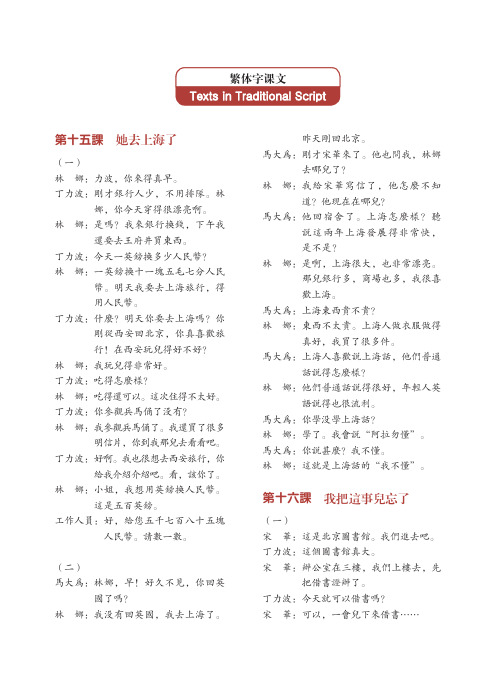
繁体字课文 Texts in Traditional Script
3
林 娜:可是也貴多了。 宋 華:比那件貴多少? 林 娜:貴九十塊錢。 宋 華:絲綢的當然貴一點兒。 林 娜:好吧,我就買這件。宋華,現在
該去買你的了。你穿多大號的? 想不想試試那套西服?
第十八课 我聽懂了,可是記錯了
(一) 馬 大 爲:小姐,我要寄這個包裹。 工作人員:好,我看一下。 馬 大 爲:這些書都是新的。這四本書是
第二十课 (複習) 過新年
王小雲:中午咱們都去宋華家吃火鍋, 他爸爸媽媽請我們跟他們一起 過新年。
林 娜:在北京過新年一定很有意思。 小雲,爲甚麽北京很多飯館都 有火鍋?是不是因爲現在天氣 冷,所以北京人常吃火鍋?
王小雲:不是。北京人就愛吃火鍋,主 要是涮羊肉,天氣熱的時候也 吃。北京的涮羊肉跟北京烤鴨
還書。 工作人員:好。……您的書過期了,您得
交罰款。 宋 華:真對不起,這個月太忙,我把
這事兒忘了。罰多少錢? 工作人員:一本書過期一天罰兩毛,您借
了四本書,過了十天,應該交 八塊錢。 宋 華:給 您 八 塊 。 請 問 漢 語 課 本 在 哪兒? 工作人員:那兒有電腦,您可以先查查。 丁 力 波:有外國人學漢語的課本嗎? 工作人員:有 。 您 找 一 找 《 新 實 用 漢 語 課本》。
應該自己填表。
丁 力 波:好吧,我自己寫。“姓名”?
宋 華:“丁力波”。
丁 力 波:“性别”寫甚麽?
宋 華:自己看。
丁 力 波:自——己——看?啊,性别應
該寫“男”。“職業”呢?
宋 華:寫“學生”。好了。你把這
張表和照片交了,一會兒那
位先生就給你借書證了。
(二) 宋 華:我們借書證辦了多長時間? 丁 力 波:辦了十五分鐘,辦得真快。 宋 華:今天辦證的人不多。力波,
CHINESE 2 Midterm Exam 新实用汉语课本 第15-18课 测试

CHINESE 2 Midterm Exam 第15-18课期中测试姓名:_______________ 成绩:_____________一.根据拼音填空:(18%)1.(rínmínbì)换美元,今天的汇率是多少?2.你的(pŭtōnghuà)说得真(liúlì)。
3.我想办一本(hùzhào),请问要多长时间?4.这里禁止吸烟,违者(fákuăn)。
5.(qípáo)是中国的传统服饰,在很多(shāngdiàn)都有卖。
6.哪儿有卖(sīchóu)衬衫?二.选择题:(20%)1.这是你的表,请写你的名字。
A 上B 来C 去D 起2.我要美国寄一个礼物。
A 去B 拿C 请D 往3.罗马坐飞机去中国,需要11个小时。
A 往B 从C 到D 在4.没有做完作业,他不吃饭。
A 才B 就C 还D 也5.那件黑的有点儿小,那件红的太大了,这件白的很。
A 不大B 合适C 不小D 颜色好6.那个中国留学生来这儿时间了?A 很多B 多少C 多长D 多久7.你在中国生活,应该填表。
A 大家B 自己C 咱们D 我8.不好意思,我________听懂你说的话。
A 没有B 不C 不是D 也9.您的书过期了,您得________ 罚款。
A 送B 取C 办D 交10.我______ 那本书的名字忘了。
A 给B 想C 把D 跟三.用所给词语组成句子:(15%)1.多寄了比航空慢海运寄。
2.往走下要后请车的。
3.今天带把借书证我了来。
4.听没有听懂有你。
5.听没有懂有你老师语法说的。
四.用括号里的词语,把下列句子译成中:(40%)1.Look at this character . Did I write it correctly. (得,看)。
2.Our teacher teaches grammar too slowly.(得,太…了)。
新实用汉语课本件及课后答案PPT课件
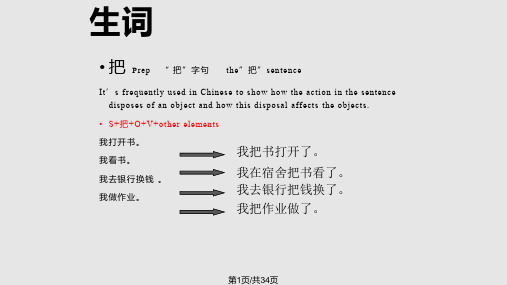
练习
4.Conversation practice 认识新朋友 Meeting a new friend (1) A:您好,您要出去啊。 B:您好!您也住这儿? A : 我 住 九 楼不好,意这思是 我 的 名 片 。 B:谢谢。________________,我没有带名片。我姓王,住三楼。 A:王先生,认识您很高兴,有时间上来坐坐。 B:好的。
熟读下列词组readfollowingphrasesunilyoulearnheart1现在就去今天就来星期六就看电影下午就去图书馆借书2自己写自己念自己拿自己带自己复习自己锻炼自己旅行她们自己去借书她自己去买东西他自己洗衣服他们自己翻译课文马大为自己租房子我自己打扫宿舍我自己练习口语3上来上去下来下去进来进去出来出去上楼去下楼来寄钱去寄明信片来回宿舍去回家来到西安去到北京来带照片来带英镑去拿一本书来第25页共34页练习1
•慢
写得很慢 学得不慢 说得真慢
快
•不行
我可以明天交作业吗? 不行 我可以不写作业吗? 不行 我们今天可以不考试吗?不行
第7页/共34页
生词
•生活
在中国生活 在海口学习和生活 生活得很好 快乐的生活 我在中国生活得很好。
•自己
你自己 我自己 自己看 自己写 自己填 做自己 自己听写,不要看别人。
第8页/共34页
丁力波:“性别”写什么?
宋华:自己看。
丁力波:自——己——看?啊,性别应该写“男”。“职业” 呢?
宋华:写“学生”。好了。你把这张表和照片交了,一会儿 那位
先生就给你借书证了。
第17页/共34页
生词
•长
很长 长时间 多长 多长时间
昨天我去银行换钱,花了很长时间。
新实用汉语课本2第15课,课件及课后答案讲解学习
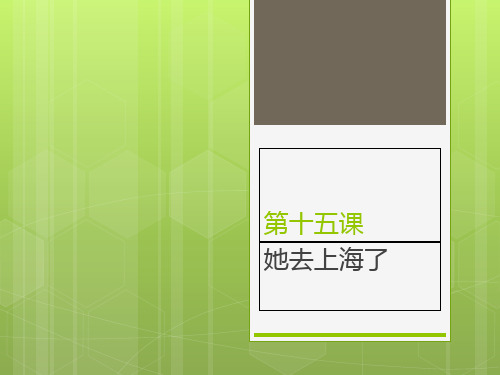
3. The V/A-not-V/A question form:
V + 得 + A + 不A?
她来得很早。
她来得早不早?
他吃得很多。
他吃的多不多?
她写得很多。
她写得多不多?
练习
He runs very fast. He came here very early.
他跑得很快。 他跑得不快。 他跑得快不快?
信用卡
亚洲学系 亚洲 非洲 欧洲
城市 上海是一个很大的城市。
地方 你想去什么地方?
儿子
菜
买菜 我每天开车去买菜。
课文
马大为:林娜,早! 好久不见 ,你 回英国了吗? 林娜:我没有回英国,我去上海了,昨天 刚 回北京。 马大为: 刚才 宋华来了,他也问我,林娜 去哪儿了 。 林娜:我给宋华写信了,他怎么不知道?
你真喜欢旅行!在西安玩儿得好不好? 林娜:我玩儿得 非常好 。 丁立波:吃得怎么样? 林娜:吃得还可以。这次住得不太好。 丁立波:你 参观兵马俑了没有? 林娜:我参观兵马俑了。我还买了很多明信片,你到我那儿 去 看看吧。 丁立波:好啊。我也很想去西安旅行,你给我 介绍介绍 吧。 看,该你了。
课文
李娜:小姐,我想用 英镑 换 人民币。这是五百英镑。
1英镑=9.7341元
Rénmínbì 人民币
RMB
生词
排队 排队挂号 排队买书 排队上车 不用排队
生词
得 得换钱 得排队
明天有汉语考试,我得复习课文和语法。
用 用手洗衣服 用英镑换人民币
借我用一下手机。
刚 我刚去银行取钱。
我刚去邮局给妈妈寄东西。
生词
从
从 + 地方1 + V+ 地方2
新实用汉语第二册

• 读课文接龙 • 每个人读一句 • 大家一起来纠错
三人一组,分角色表演课文
• 会话练习 • P235
P237阅读与复述
• 读五分钟,复述课文。 • 昨天张大力吃了————后,和女儿去————。 在路上,有一个人问他这儿有没有——,大力 说——,那人又问你有没有——叫110,大力又 说——。那人拿出——,让大力把他的———— ——给他,可是大力是————,他把那个坏人 抓到了————。
•对 • 对中国文化有兴趣 • 他对她有兴趣。可是他不敢说。 • 对.....说 • 妈妈对我说:———————— • 他对她——————。
感兴趣
• 结业 • 他们学习一年,现在结业了。 • 结业聚会 • 快要结业了。 • 结业的时候
• 记得 • 我记得我小时侯最喜欢玩这个游戏。 不记得他的名字。 记得以前的朋友。
自己读一遍课文,不懂得地方问老师。
读课文回答问题
• 1、王小云让宋华去哪儿?为什么? • 2、林娜怎么了? • 3、林娜是怎么被撞伤的? • 4、林娜和王小云是怎么被送到医院的? • 5、林娜伤得重不重?
• 王小云:宋华,你来帮我们一下,好 • 吗? 小组表演 :你们怎么了?现在你在哪儿? • 王小云:林娜被撞伤了,正在第三医院 • 检查呢。 :她伤了哪儿了?伤得重吗? • 王小云:还没有检查完呢。你带点儿钱 • 来。 :好的,你们等着,我马上就来。
• 历史 • 如果你去—————,你会了解 • 柬埔寨的——————。
• 中国的历史很——————。
• 中国和柬埔寨在历史上是好朋友。 • 博物馆 • 历史博物馆 • 文化博物馆 • 美术博物馆 • 一座博物馆
• 举办 • 举办音乐会 • 举办足球比赛 • 2016年奥运会在——举办 • 2020年奥运会在——举办 • 图片 • 一张图片 • 两张图片 • 历史图片 • 展览图片
培训资料《HSK标准教程2》第15课课件.ppt
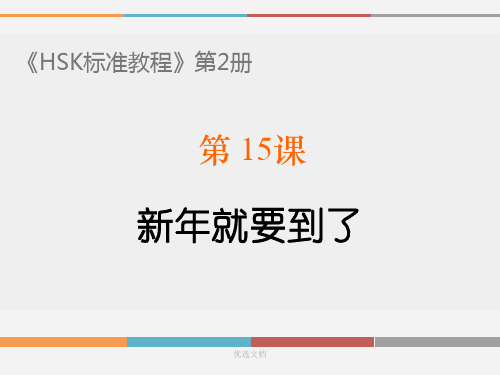
欢度新年 火车票
优选文档
4
新年 票 旅游 帮助 阴 火车站
新年快乐
欢度新年
飞机票
火车票
去哪儿旅游
去国外旅游
优选文档
5
新年 票 旅游 帮助 阴 火车站
新年快乐
欢度新年
飞机票
火车票
去哪儿旅游 去国外旅游
姐姐帮助弟弟
帮助老人
优选文档
6
新年 票 旅游 帮助 阴 火车站
新年快乐 欢度新年
飞机票
火车票
去哪儿旅游 去国外旅游
阴天
小雨转阴
北京火车站 去火车站买票
优选文档
9
时间状语 S
明天
他
Predicate
快要/快/就要/要 V+O
就要
来
了 了。
一会儿 天
要
下雨 了。
十分钟后 火车 就要
来 了。
新的一年快要到了。 我们就要回国了。 下个星期,我们就要开始了。
优选文档
10
都 都 八点
了 了,
快起床。
你都是成年人了,可以自己去买东西。
都十二点 了, 商店都关门了。
你都8岁了,可以自己洗衣服了。 都等她半个小时了。 弟弟都3岁了,可以自己吃饭了。
优选文档
11
在朋友家
A:今天是12月20日,新年就要到了。
B:新年你准备做什么? A:我想去北京旅游,北京很不错,我去过一次。
B:你买票了吗?
A:还没有呢,明天
就去火车站买票。
优选文档
12
在公司
A:时间过得真快,新的一年快要到了!
B:是啊,谢谢大家这一年对我的帮助! A:希望我们的公司明年会你妹妹怎么还没来?都八点四
新实用汉语第二册PPT优秀课件

•
找到导游 睡到十点 拿到借书证
• 动词+在 停在楼前 写在本子上 住在郊区
•
站在阳台上 躺在床上 放在桌子
22
• 宋华:你们是怎么到医院来的?
• 林娜:那位司机看到我被撞伤了,就马上开着车
•
送我们到医院。
• 宋华:那位司机真不错。
• 林娜:我们带的钱不多,医药费都是他帮我们
•
交的。他还给了我一张名片。
第二十五课 司机开着车送我们到医院
1
生词
•着
• 1.动作正在进行 verb+ing
•
•
他笑着。
•
他笑着说:我是张国立。
•
•
她哭着。
•
她哭着说:————————。
2
verb+着+object
他打着—————。
她———————。 ————————。
3
他|她|他们+怎么+做什么? 她---------------去医院。
10
•骑
骑自行车
骑———— 骑————
11
笑
• 喜欢笑 • 别笑了 • 笑着说 • 大笑
•哭
12
• 注意红绿灯 • 注意———— • 注意———— • 没有注意
13
•停 • 停车 • 停在———— • 停——
14
• 医药费
• 以为 • •
我以为她是柬埔寨人,————————
•
•
他以为他—————,——————
20
• 王小云:宋华,你来帮我们一下,好
• 小:组你表们吗演怎?么了?现在你在哪儿?
• 王小云:林娜被撞伤了,正在第三医院
- 1、下载文档前请自行甄别文档内容的完整性,平台不提供额外的编辑、内容补充、找答案等附加服务。
- 2、"仅部分预览"的文档,不可在线预览部分如存在完整性等问题,可反馈申请退款(可完整预览的文档不适用该条件!)。
- 3、如文档侵犯您的权益,请联系客服反馈,我们会尽快为您处理(人工客服工作时间:9:00-18:30)。
请你介绍介绍你的国家。
我很好,你呢?
Lesson 15
生词: páiduì to form a line; to queue up 排队 排:to arrange; to put in order
队:a row of people; line
排队上车 排队买东西
排两个队
不用排队
huàn 换
yīngbàng 英镑 pound sterling
The negative form of the structure “V + 了” is “没(有)+ V” and “了” must be deleted. 我喝了两杯咖啡。 我没喝咖啡。
她去上海了
The 了2 emphatically confirms the completion or realization of some event or situation.
cóng 从 沈阳去北京。 从 + 地方1 + V. + 地方2
地方1
银行
V.
去 来 回
地方2
书店 学校 德国
从
家 中国
gāi 该 + NP + (V) + 了 it’s somebody’s turn (to do something) 该你打扫宿舍了。
该你换钱了
Lesson 15 她去上海了
Four kinds of simple sentences:
1.动词谓语句 sentence with a verbal predicate
这个星期四是我的生日。
2.形容词谓语句 sentences with an adjectival predicate 我很高兴。 爸爸妈妈身体都很好。
3.名词谓语句 sentences with a norminal predicate
Reduplicating a verb has the function of implying a short duration for that action or the idea of giving something a try. In this sense, it is similar to adding 一下 to the verb. 介绍介绍 介绍一下
If “了” occurs in a sentence and the verb is followed by the object, the object is usually preceded by a numeral measure word or other attributives.
S + V + 了 + Num/Adj/Pron + O
to change; to exchange
Rénmí nbì 人民币
RMB
gāng 刚 gāngcái 刚才
(Adv) just; only a short while ago
(nouns of time) just now
刚(刚刚)is an adverb, it expresses that an action or a situation took place a while ago, while 刚才is a noun, it refers to the time that just passed. They have different parts of speech and different usages.
今天星期一。 4.主谓谓语句 sentences with a subject-predicate phrase as predicate 沈阳东西贵不贵?
Six question types
1.用“吗”提问 questions with “吗” 你是美国人吗? 2.正反疑问句 V/A-not-V/A question 你吃不吃鱼? 3.用疑问代词的问句 questions with an interrogative pronoun The interrogative pronoun: 谁、什么、哪、哪 儿、怎么、怎么样、多少、几
吃 得
走 得
ቤተ መጻሕፍቲ ባይዱ
不
不
好
远
(3) The V/A-not-V/A question form:
V + 得 + A + 不 A?
睡 走 得 得 好不好? 累不累? 睡得好吗? 走得累吗?
(4) In this kind of sentence, if there is an object following the verb, the verb needs to be reduplicated and then placed after the object, but before “得”. The first verb is often omitted.
我喝了一杯咖啡。
林娜吃了很多东西。
他借了我的自行车。
Generally speaking, a sentence with a verb followed by “了” cannot exist alone unless there is an attributive before the object; if not, it must be followed by another sentence. 我买了苹果。 × 我买了苹果,还买了香蕉。 √ 今天早上我吃了面包,还喝了牛奶。
4.用“还是”的选择问句 alternative questions with “还 是” 你吃苹果还是葡萄?
5.用“好吗?”(或“是不是?”、“是吗?”、 “可以吗?”)的问句 the questions with “好 吗?” 、“是不是?”、“是吗?” or “可以吗?
6.用“呢”的省略式问句 Elliptical questions with the question particle “呢”
The particle 了2 . It always appears at the end of a sentence.
The particle 了1 can follow a verb to donate the completion or realization of an action. 我买了一本书。 S+V+了+O 我吃了一个苹果。
S + V + O + 了。
我吃饭了。 我下班了。
我生病了。
S + 没(有) V + O + 了。 我没吃饭。 我没上课。
她没去上海。
To form a “V 不 V” or “A 不 A” question, juxtapose the affirmative form of the verb with its negative(“…没…”), or add “…了没 有” to the end of an affirmative sentence.
(V) + O + V + 得 + Adv + A.
Reduplication of the verb
shǔ shǔ 数一 数
多少钱
看一看 (看看) 听一听 (听听)
In Chinese, verbs can be reduplicated. The form:
AA/A一A
说一说
ABAB
介绍介绍 学习学习
你吃饭了没有?
你吃没吃饭?
她每天早上6:30来学院。 他早上吃了8个面包。
她来得很早。 他吃得真多。
她昨天写了100个汉字。
她写得很多。
The complement of state
P15
(1)V + 得 + Adv + A.
吃 得
穿 得
很
很
饱
漂亮
(2) The negative form:
V + 得 + 不 + A.
